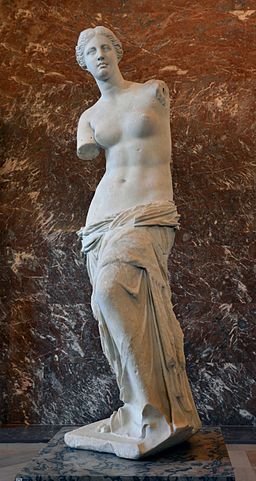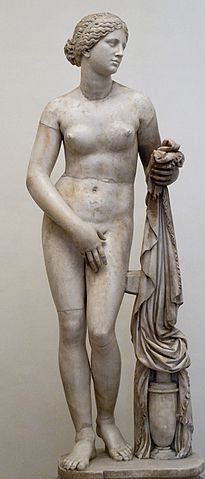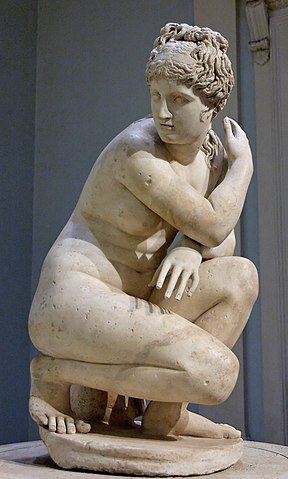All entries for Tuesday 10 January 2023
January 10, 2023
The Male Gaze Made Marble? The Venus de Milo, by Katharine Broderick
The Venus de Milo, which can be found in the Louvre Museum in Paris, is one of the most famous Hellenistic artworks in the world. The Venus is a sculpture by Alexandros of Antioch, although little is known about the artist. The statue was found on the Aegean island of Melos in 1820, possibly by a member of the French Navy, named Olivier Voutier, who anchored in Melos and spent time digging through the remains of a theatre and searching for antiquities. There are also rumours, however, of the Venus being found by a Greek farmer, so the story of its discovery remains contentious.
The Venus (Figure 1) stands at slightly larger than life size, at around six foot seven inches. She stands in contrapposto (counter pose), with a realistic weight distribution, echoing the naturalistic aspects of Hellenistic art. Perhaps the most noticeable element when initially viewing the statue is her lack of arms, encouraging the audience to question where her arms are, the original positioning of them, and whether she was holding anything. Some claim that the “left hand [was] holding an apple”, (Arenas (2002) 37) although this is a topic of debate amongst scholars. If true, it implies that the Venus de Milo is in fact a representation of Aphrodite, as is generally accepted. Kousser suggests that “Aphrodite likely held out an apple in token of her victory in the Judgement of Paris” (Kousser (2005) 227).
 |
Figure 1: The Venus de Milo, Accession number: LL 299, Louvre Museum, Paris. Image from Wikipedia Commons, CC BY-SA 4.0. |
The Judgement of Paris was a contest which stemmed from the wedding of Peleus and Thetis. All gods and goddesses had been invited bar Eris, goddess of discord. She attempted to attend despite the lack of invitation and was turned away, but in her anger she cast the golden apple which was addressed “To the Fairest”. Consequentially, three goddesses laid claim to the apple: Aphrodite, Hera and Athena. Zeus commanded Hermes to lead the goddesses to Paris of Troy to decide the winner. Aphrodite promised to bestow upon Paris, Helen, the most beautiful woman, to be his wife, which swayed him to announcing Aphrodite as the winner. According to scholarship, the Greeks had understood the Judgement of Paris as symbolising “a man’s three choices: war (Athena), politics (Hera), or love (Aphrodite)” (Stewart (2014) 163). As well as alluding to the Judgment of Paris, it was a pun on the island’s name; mēlon is the Greek for apple, and the fruit also feature strongly on Melian coins. The statue is half nude, with a drape hung around her hips. It is believed by some that the right hand was once in place holding up the drape, while the left held an apple, whilst leaning on a pillar. The style of ‘wet drapery’ was very popular in the late fifth century BC. Some scholarly debate exists over whether there was a reason why the Venus was depicted naked, yet due to her links to love and sexual love, she often was presented as such in other versions of Aphrodite and Venus.
The Aphrodite of Knidos
The Venus de Milo is understood to have been inspired by the Aphrodite of Knidos. The Aphrodite (Figure 2) was created by Praxiteles in Parian marble between 360 and 330 BC, and was supposedly based on his lover, the courtesan Phryne. Supposedly, this was the first life-sized representation of the female nude form in Greek history. This was part of the controversy surrounding the Aphrodite. Praxiteles created two versions, one clothed, the other nude. The island of Kos, who had the choice, rejected the nude version in outrage. The island of Knidos then bought the nude version. This Aphrodite does not survive, having been destroyed in a fire.
|
Figure 2: The Aphrodite of Knidos, Roman copy of the Greek 4th century BC original. Inv. 8619, Museo Nazionale Romano de Palazzo Altemps. Image from Wikimedia Commons, Creative Commons CC0 1.0. |
 |
The Aphrodite of Knidos stood, supposedly either about to get into the bath or having just left it, with a hand covering her groin. This statue quickly became synonymous with the island of Knidos, even being depicted on their coins. Tourism increased massively as individuals travelled to visit the famous sculpture, as commented by Pliny in his Natural History: “Praxiteles made Cnidus a famous city”, (Pliny, N.H. 10.36.4) and led to a huge boost to the economy of the island. Further to this, the Aphrodite was so popular that King Nicomedes of Bithynia was anxious to buy the sculpture and offered to discharge the state’s vast debts in payment but was refused by the island (Pliny, N.H. 10.36.4). The wealth of the island increased massively due to the tourism the Aphrodite attracted.
The Aphrodite of Knidos inspired copies and derivatives in antiquity which survive, particularly through the Venus de Milo, but also through other versions such as the Capitoline Venus and the Crouching Venus. There is much scholarly debate deriving from this statue, such as how the circular temple may have been laid out so individuals could admire this cult statue. Unfortunately, one of the most detailed sources which remain, Pseudo-Lucian’s Amores, is not incredibly reliable, and is likely to be heavily embellished (Montel (2010) 266). Despite this, however, the Aphrodite of Knidos was a ground-breaking statue who provides a key insight into the inherently sexist views at the time, and how those views can still be seen millennia after her creation, even echoing today.
The Male Gaze, Made Marble?
All of these sculptures, as well as depicting the Greek or Roman goddess of love and beauty, have other things in common too. Most importantly, the sculptures are nude and promote the ideas of modesty and innocence.
First, the Aphrodite of Knidos was placed in a round temple, meaning she could be approached from any angle (Pliny, N.H. 10.36.4). The Aphrodite is said to be smiling, some say at Ares (Stewart (2014) 179), her lover, and some say at the viewer. I believe that this statue is seen as sensual due to the fact that the viewer has walked in on her, either during an intimate moment with her lover, or during a moment alone. No matter what angle an individual would approach this statue from, it would still feel as though an individual was ‘walking in’ on the goddess.
 |
Figure 3: The Capitoline Venus, Inv. MC0409, Palazzo Nuovo, Musei Capitolini, Rome. Image from Wikimedia Commons, CC BY-SA 4.0. |
The Capitoline Venus (Figure 3) also covers areas of her body from prying eyes, despite being nude, and other versions such as the Crouching Venus (Figure 4) depicts the Venus crouching covering her breasts, with her head turned as she looks over her shoulder. In each of these versions, therefore, the Aphrodite or Venus is, in some way, posed in a way to make the viewer feel as though they are intruding on a private moment. We can wonder why that is the case.
|
Figure 4: Crouching Venus, (Lely's Venus), Accession No. GR1963.10-29.1, The British Museum, London. Image from Wikimedia Commons, Public Domain. |
 |
The popularity of these sculptures may be reflective of the patriarchal society which still exists today. Now, if a celebrity, particularly someone identifying as female, was to experience an unexpected leak of sensual images or videos, the media would consider this to be excitingly provocative, whereas if an individual releases sensual images or videos purposefully, they are seen as vulgar and disgusting. Realistically, the key difference between these scenarios is that in the latter she has granted her consent. If the Aphrodite was posing in a way which was not modest, where she was not attempting to partially cover herself from the prying eyes of visitors to her sculpture, it would be seen differently, and while the sculpture may still have been as famous, this could have been due to its notoriety. The surviving epigrams also highlight this idea of modesty. Frequently recorded is the supposed quote from Aphrodite: “where did Praxiteles see me naked?”, (Plato, The Greek Anthology 16, Book XVI, Number 160) and others with similar meanings, such as “None ever saw the Paphian naked, but if anyone did, it is this man who here erected the naked Paphian” (Lucian, The Greek Anthology 16, Book XVI, Number 163). This notion that no one had seen Aphrodite naked furthers the idea of her innocence, which adds to the sexual appeal of the statue, as individuals appear to be watching a modest creature who exists just for their eyes, and even if her pose was to draw the viewer in, and the positioning of her hand to draw attention to her groin, her innocence is seemingly broken for that individual only, and thus the appeal remains.
The Venus de Milo, as a sculpture inspired by the Aphrodite of Knidos, can give us a real insight into the reception of these nude or semi-nude depictions of the goddess, and can help us to raise our own questions around the depiction of women in ancient sculpture. The sculpture can also help us to think about depictions of women in the media today.
Bibliography
Primary Sources:
Lucian. Soloecista. Lucius or The Ass. Amores. Halcyon. Demosthenes. Podagra. Ocypus. Cyniscus. Philopatris. Charidemus. Nero. Translated by M. D. MacLeod. Loeb Classical Library 432. Cambridge, MA: Harvard University Press, 1967.
Pliny. Natural History, Volume X: Books 36-37. Translated by D. E. Eichholz. Loeb Classical Library 419. Cambridge, MA: Harvard University Press, 1962.
The Greek Anthology, Volume V: Book 13: Epigrams in Various Metres. Book 14: Arithmetical Problems, Riddles, Oracles. Book 15: Miscellanea. Book 16: Epigrams of the Planudean Anthology Not in the Palatine Manuscript. Translated by W. R. Paton. Loeb Classical Library 86. Cambridge, MA: Harvard University Press, 1918.
Secondary Sources:
Arenas, A. (2002) 'Broken: The Venus de Milo’ in Arion Volume Nine, Number Three.
Kousser, R.M. (2005) ‘Creating the Past: The Venus de Milo and the Hellenistic Reception of Classical Greece’ Vol 109, No. 2, ‘American Journal of Archaeology’ (Archaeological Institute of America).
Montel, S. ‘The Architectural Setting of the Knidian Aphrodite’ in Brill’s Companion toAphrodite, Chapter 13, pp. 251-268, ed. A. Smith and S. Pickup (2008, KoninklijkeBrill, Leiden, The Netherlands).
Stewart, A. Art in the Hellenistic World: An introduction (2014, Cambridge University Press, New York).
 |
This post was written by Katharine Broderick, an MA (by Research) student of the Department of Classics and Ancient History at the University of Warwick. Katharine's interests mainly focus on the influence of ancient Athenian politics on modern democracies, and also how the ancient world influences modern life more broadly. |
 Jacqui Butler
Jacqui Butler

 Please wait - comments are loading
Please wait - comments are loading
 Loading…
Loading…